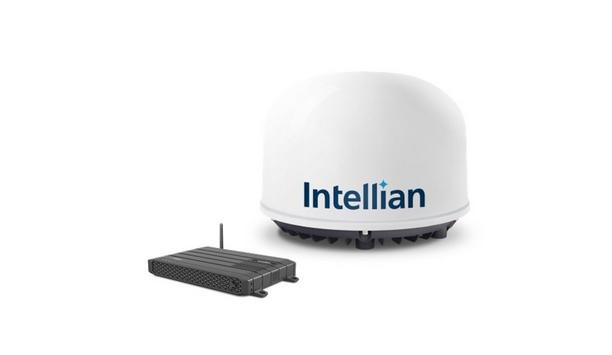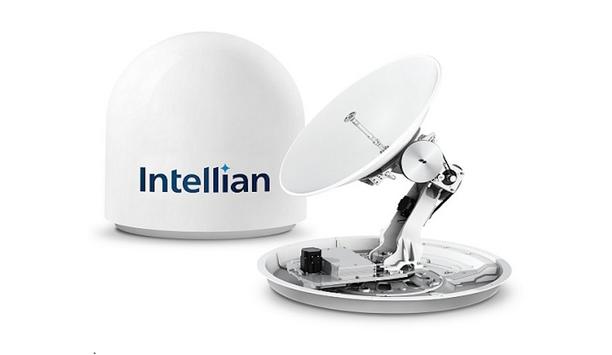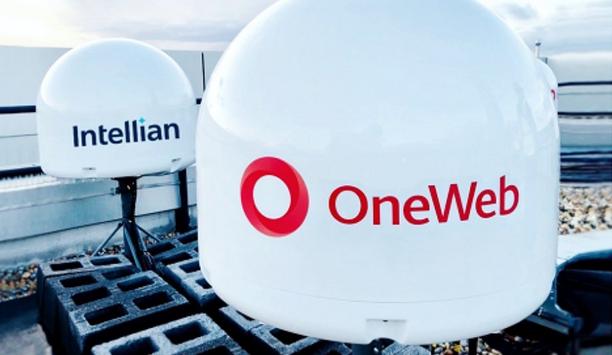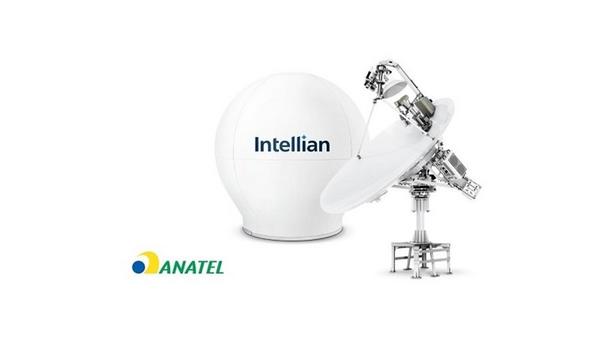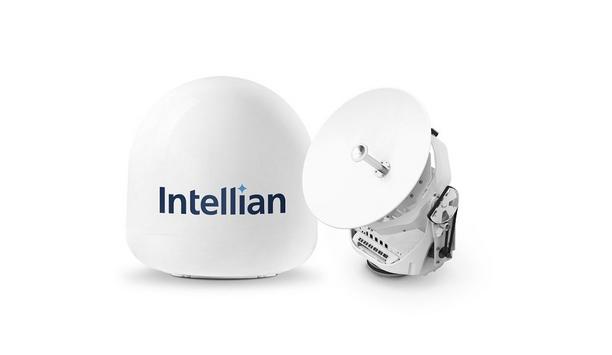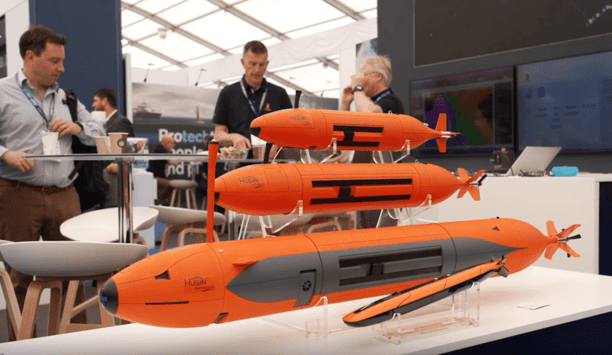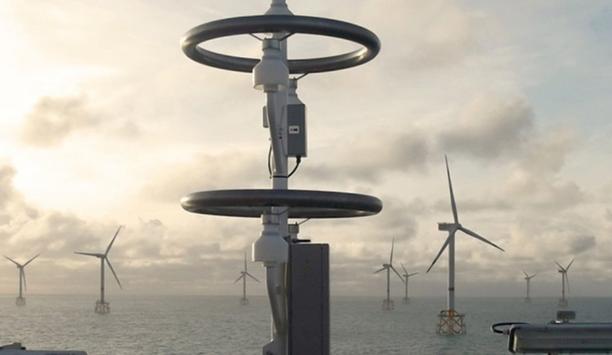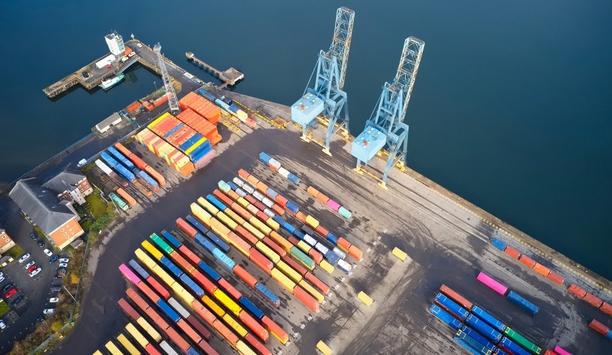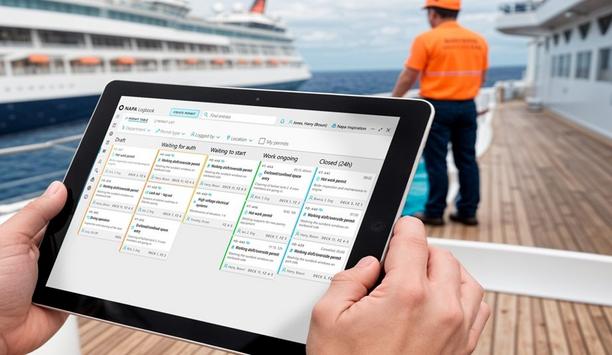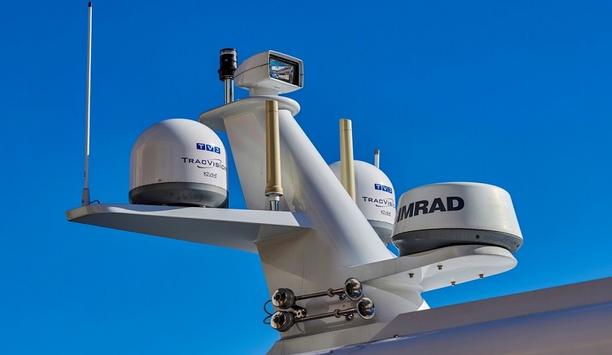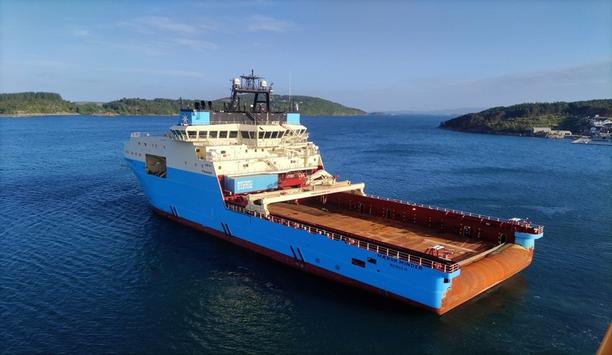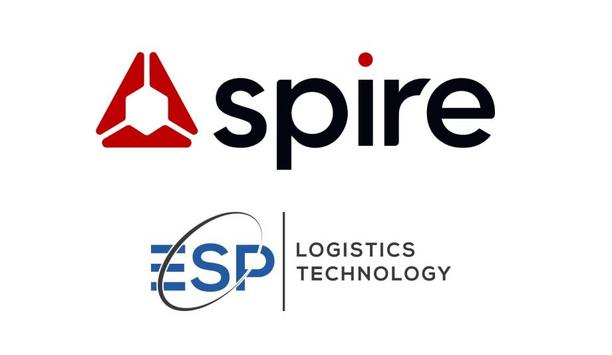Big data
Intellian’s eagerly-awaited C700 Iridium Certus® maritime terminal has now been launched and is expected to quickly secure a reputation as the most powerful and technically advanced Iridium Certus® terminal on the market. With its best-in-class RF performance, the C700 can deliver out-of-the-box uplink speeds of 352kbps and downlink speeds of 704kbps by default, with equally impressive low-elevation-angle RF efficiency thanks to its unique 12-patch phased array antenna technology....
Intellian is pleased to reveal that two of its industry-pioneer antenna systems, the v60Ka 2 and v100NX Ka, have gained type approval from Telenor Satellite for use on their THOR 7 Ka-band GEO satellite network. This means that the systems are now officially certified to take their place in service alongside Intellian’s v85NX, the first 85cm antenna to receive type approval on the network. The Intellian v100NX Ka delivers market-pioneer RF performance and is future-proofed with a special...
Satcomms is one of the most competitive and challenging sectors in the superyacht industry. Mobile communications on shore are developing at a tremendous pace, with users now able to experience similar connection speeds when roaming as they do in the home or office, and these high expectations continue when an owner or their guests and crew board a yacht. Yet delivering seamless and efficient connectivity at sea is a demanding task: gaming, video streaming, 8K TV, on-board cinema, socialising...
Intellian is delighted to announce that it will be commencing the production of a wide range of dedicated user terminals for the global low-earth orbit (LEO) satellite communications provider OneWeb, ready for delivery in 2021 and beyond. Looking to 2021, OneWeb is focused on scaling the satellite constellation to begin commercial services starting at the end of next year to the UK, Alaska, Canada, Northern Europe, Greenland, Iceland, and the Arctic Seas. Intellian announced its partnership wi...
Intellian is pleased to announce that it has received approval for its v240MT 2, v240M 2, v240M and v150NX antennas from the Brazilian National Telecommunications Agency, ANATEL. These powerful, high-throughput antennas are widely used in the energy industry, so this approval opens the door for Brazil’s extensive oil and gas market to adopt Intellian’s antenna technology. Brazilian regulations Telecommunications products to be sold and used in Brazil must have a Certificate of Con...
Intellian is proud to announce the v45C, the smallest antenna the company has yet developed for the maritime satellite communications market. The C in the product name represents its compact form factor. This new 45cm unit will bring VSAT to new markets where there is limited space available for communications equipment, such as workboats, leisure craft, fishing boats, small commercial and government vessels. The v60E & v45C The v45C extends the portfolio still further, opening up a new...
News
Indian Register of Shipping (IRS), a pioneering international ship classification society and member of the International Association of Classification Societies (IACS), is proud to announce the opening of its new office in the Kingdom of Saudi Arabia. This strategic expansion highlights IRS’s commitment to supporting the Kingdom’s rapidly growing maritime and oil & gas sectors. IRS full suite of services With the placement of the Dammam, IRS will offer its full suite of services across all ports in Saudi Arabia With the establishment of the Dammam office, IRS will offer its full suite of services across all major ports in Saudi Arabia. This move will enable closer engagement with local clients, faster service delivery, and dedicated support to ship owners and operators in the region. The new office strengthens IRS’s regional footprint, ensuring timely, competitive, and high-quality services to clients operating in and around the Persian Gulf and the Red Sea. IRS’s global growth journey Services offered will include ship classification, statutory surveys and certification, technical inspections, ISM/ISPS/MLC audits in compliance with IMO and flag state requirements. “Our new office in Saudi Arabia marks a significant milestone in IRS’s global growth journey. It reflects our long-term commitment to serving the maritime industry in the Kingdom and supporting its transformation into a world-class logistics and shipping hub,” said Mr. P K Mishra Managing Director, IRS.
HydroPenTM, the unique VIKING Life-saving Equipment container firefighting solution, has secured a first major order from an Asian shipowner, in a deal that also demonstrates that the technique is highly adaptable for all sizes of container vessels. Singapore-based PIL, the largest container carrier in Southeast Asia, is committing its entire container ship fleet of around 100 vessels to carrying HydroPen™ systems. Drill and Douse The TT Club estimates that a container fire occurs on average once every 60 days Conventional container firefighting equipment dowses the box exterior and has been increasingly ineffective in an industry experiencing nine major container ship fires in 2019, and 10 incidents in 2020*. The TT Club estimates that a container fire occurs on average once every 60 days. While the International Union of Marine Insurance has called for design and firefighting equipment improvements for Ultra Large Container Vessels, 2021 incidents off Malaysia and Sri Lanka have highlighted that container fires can also devastate smaller ships. Attached to a ship’s hose and raised on a telescopic arm by a single crew member, HydroPen’s ‘drill and spray’ nozzle is powered by water pressure alone to drill through the container door, then switches to spray mode to extinguish a fire with water, foam or C02. The system can be deployed to fight container fires in the hold, as well as above deck. Safety through innovation “With focus on our people, PIL is committed to seeking out new technologies and solutions which enhance the safety and security of our seafarers and our vessels. ,” said Goh Chung Hun, General Manager, Fleet Division, PIL. “HydroPen has provided a breakthrough in fire safety for large containerships; its user-friendliness in testing convinced us that it is a powerful safety tool for our fleet of container ships of varying sizes. As the HydroPen™ system is able to meet our stringent safety standards, we are delighted to introduce HydroPen fleetwide.” Standardizing safety "Deliveries are underway for the phase-in, with crews provided with VIKING training materials and a dummy nylon-tipped drill attachment to test procedures. “We have supported HydroPen™ since its inception, introducing it to market as exclusive distributor in 2019 before purchasing the technology outright earlier this year,” says Lasse Boesen, Senior Product Manager, VIKING. “We were always convinced we had a hit on our hands and ULCV orders confirmed that. PIL’s commitment sees the solution establishing itself as the new standard for container firefighting, with equipment supplied the same for all ship capacities."
ClassNK has granted its Innovation Endorsement for Products & Solutions to the maritime cybersecurity solution, ‘CYTUR TM’ and ‘CYTUR SC-P’ (components of Rakuten Maritime) developed by Rakuten Symphony and its partner company CYTUR. In order to promote the spread and development of innovative technologies, ClassNK has offered Innovation Endorsement for Products & Solutions. ClassNK supports the deployment of products and services through third-party certification for equipment and software technology with innovative functions. Product name: ‘CYTUR TM’, a software analysing and visualising cyber threats to the vessel through threat modelling techniques during the design phase Product descriptions: Identification of CBSs (Computer-based system) based on vessel design data Threat analysis through cyber threat modelling for the vessel Identification of attack surfaces on CBS to detect known vulnerabilities Product name: ‘CYTUR SC-P’ is a hard/software identifying and classifying equipment by scanning the onboard network system Product descriptions: Automatic setting of the available network bandwidth of the vessel's onboard network system Automatic booting structure upon power-on optimised for the commissioning phase Automatic identification of maritime equipment on a vessel during the commissioning or sea-trial phase by being installed in multiple network zones Equipment classification based on ship equipment data Identification of CBS vulnerabilities and attack surfaces with a corresponding risk score through scanning of the ship network
Kongsberg Discovery is gearing up to make a splash at Ocean Business 2025, with high profile product demonstrations, a new digital innovation launch, and a range of domain experts on hand to help stakeholders navigate a future of ocean opportunity. The company, a global pioneer in advanced underwater robotics and sensor technology, will base itself at booth N1/P2 for the duration of the show, taking place 8-10 April at the National Oceanography Centre, Southampton, UK. Multibeam in action Kongsberg Discovery has teamed up with Saildrone to give insight into remote deep-water multibeam survey Demonstrations on all three days will showcase the EM2042 Multibeam Echosounder and Seapath 385 GNSS aided inertial navigation system onboard the Fugro FTV Xplorer vessel, in addition to dockside demos with the Flexview multibeam sonar deployed on a ROV for underwater infrastructure inspection and gas seep detection. Kongsberg Discovery has also teamed up with Saildrone to give delegates an insight into remote deep-water multibeam survey operations, with a real-time demonstration of a Saildrone Surveyor USV fitted with EM304 MKII sensors and software. Empowering developments Stene Førsund, EVP, Kongsberg Discovery, says it’ll add up to a “memorable three days for us, our partners and anyone that wants to get a taste of next generation ocean technology.” Førsund continues: “Ocean Business operates as a key hub for the ocean technology community, with a broad range of stakeholders congregating to experience innovation, share knowledge and build partnerships. For us, as an acknowledged leader in the segment, it’s a hugely important arena – both to showcase the potential of our solutions and to collaborate with others looking to empower informed, profitable and sustainable ocean development.” “We’re thrilled to be there in force, with a heavyweight team of in-house experts and some really exciting demonstrations. These will provide not only ‘first-hand’ insights into the ability of our technology, but also how we work hand-in-hand with our partners and customers for optimal results in demanding operations.” Meeting demands The Flexview demo showcases the compact multibeam sonar’s use in infrastructure inspection Each demonstration on board the Fugro vessel will last 45 minutes, with participants getting a chance to see the lightweight, robust and powerful EM 2042 in action, in conjunction with the high-precision Seapath 385, developed specifically for demanding hydrographic surveying. The Flexview demonstration, taking place dockside at set times on each day, reveals how the latest compact multibeam sonar technology can be implemented for trusted infrastructure inspection and gas seep detection. For delegates eager to experience the potential of remote operations, the Saildrone sessions on Wednesday and Thursday will show how Kongsberg Discovery’s deep-water multibeam sensors and software can be deployed to empower efficient, safe and high-quality autonomous surveying. Connecting with the future “We’re also planning on unveiling a new digital offering at the exhibition,” concludes Førsund. “This is another example of how we constantly innovate to meet market demand and create added value for our global customer base.” “Come along and chat with our expert team and you can find out more about out how we partner with users around the world to capture, process and utilise ocean data, enabling enhanced decision making, safe operations and truly game-changing ocean insights.”
Zero USV, the company behind the Oceanus12 fleet, providing the first global network of over-the-horizon, high-endurance uncrewed fully autonomous surface vessels (USVs) for charter, has officially welcomed Leeway Marine onboard as its first global operations partner. This partnership represents a landmark step in expanding Zero USV’s worldwide presence, with Leeway Marine now set to offer the company’s Oceanus12 USV for charter throughout Canada and the wider North American region. Pioneering vessel solutions This collaboration between the two companies arrives at a time when global interest in uncrewed This collaboration between the two companies arrives at a time when global interest in uncrewed. The charter-based business model is pioneering for this region and beyond; organisations no longer need to invest in costly ownership to harness the benefits of utilising a USV already set up with edge-based autonomy fed by sophisticated algorithms using data fusion from an advanced sensor suite. This collaboration between the two companies arrives at a time when global interest in uncrewed, high-endurance vessel solutions is surging, not least within the defence sector, where continuous maritime surveillance, border security, and rapid-response capabilities in contested waters have become increasingly critical. Maritime operations excellence Based in Halifax, Nova Scotia, Leeway Group was founded in 2015 by former navy professionals and is now one of Canada’s largest charter vessel suppliers in the offshore survey and defence charter market. The Group of companies includes Leeway Marine, Leeway Vessel Management, Offshore Crewing and related US subsidiaries. With operations in Canada, US and the Indo-Pacific Region, Leeway is poised to create significant growth for the Zero USV brand in current and emerging markets. Technology integration It is this core experience and knowledge which gives ZeroUSV the confidence that Leeway Marine is the right partner to take the Oceanus12 on and work it up to meet local requirements, leveraging its deep knowledge of Canadian waters and maritime operations. This collaboration ensures that Zero USV’s cutting-edge technology, specifically developed for over-the-horizon missions, is paired with specialised, in-territory expertise. Autonomous marine solutions The Oceanus12 is a next-generation uncrewed surface vessel, designed from the keel up for extended, high endurance, fully autonomous missions. Key features include a twin hybrid-electric propulsion system for ultimate reliability and fuel efficiency, an advanced autonomy software stack powered by MarineAI’s GuardianAI software, and a mission-agnostic platform that can be configured for a diverse range of operations. Seamless integration commitment Zero USV’s commitment to ‘turnkey’ solutions also providing its own Remote Observation Centre Zero USV’s commitment to ‘turnkey’ solutions is backed by it also providing its own Remote Observation Centre (ROC), ensuring seamless integration and allowing customers to simply “charter and go”. ZeroUSV founder, Matthew Ratsey, said: “We are absolutely delighted to be bringing a company of the caliber and track record of Leeway Marine into the ZeroUSV network. To have Leeway Marine as our first global franchisee is a huge milestone for both companies and Leeway’s strong track record in the Canadian maritime sector makes it the ideal partner to champion Oceanus12 in North America." “Our vision has always been to operationally scale ZeroUSV as fast as practically possible and to do this by creating a robust global network of key partners operating Oceanus12 uncrewed vessels that can address the wide range of operational needs, Leeway Marine as an early adopter will play a key role in helping us achieve the global reach we are striving for.” Global franchise milestone Jamie Sangster (CEO Leeway Group), said: “Becoming Zero USV’s first global franchisee underscores our commitment to delivering the most advanced uncrewed capabilities. We see enormous potential for Oceanus12 - from defence and security tasks to environmental surveys and infrastructure monitoring. By coupling our regional expertise with Zero USV’s proven platform, we aim to bring the benefits of autonomous maritime operations to more organisations across the North American continent.”
Fincantieri and TUI AG signed a Memorandum of Agreement (MoA) for the design and construction of two new cruise ships for the Marella Cruises brand. The value of this agreement, subject to financing and other typical terms and conditions, is considered as very important. This agreement represents a major step for Marella Cruises, which is venturing into newbuilding for the first time and has chosen Fincantieri as its strategic partner for this transformation. Customer relationship for Fincantieri At the same time, it establishes a new customer relationship for Fincantieri, expanding its client base with a fresh brand in the cruise sector. The ships will be designed specifically for the English market and have a focus on environmental sustainability. They will redefine premium cruising through refined design, high-quality materials, and a variety of spacious accommodations. The two vessels will be delivered in calendar years 2030 and 2032. Fincantieri’s ability to forge strategic alliances The ships will be designed specifically for the English market and have a focus on environmental sustainability Pierroberto Folgiero, CEO and Managing Director of Fincantieri, commented: “We are proud to welcome Marella Cruises as a new customer and to support its vision as it enters the newbuild segment. This agreement is a testament to Fincantieri’s ability to forge strategic partnerships with an expanding client base, reinforcing our long-term visibility and ensuring a high level of capacity saturation for our shipyards." "The project will bring together our expertise in ship design, innovation, and sustainability to deliver vessels that meet the evolving expectations of modern cruise passengers." Relationship with TUI Cruises Fincantieri has built a solid and successful relationship with the brand TUI Cruises, a joint venture between TUI AG and Royal Caribbean Cruises. This year in February, the Group delivered the cruise ship “Mein Schiff Relax”, the first of two InTUItion class new concept cruise ships dual-fuel powered (Liquid Natural Gas - LNG and Marine Gas Oil - MGO), while the second unit, “Mein Schiff Flow”, is currently under construction at the Monfalcone shipyard, with delivery scheduled for 2026.


Expert commentary
Health and safety are key considerations for all maritime organisations, in particular, for those operating in remote locations or where extreme weather conditions may put workforces at greater risk. With COVID-19 here to stay for the foreseeable future, it is vital that shipping organisations consider both the short and long term safeguarding measures, which are required to protect their workers at sea. COVID-19 management plans Establishing safe working conditions and providing onboard expert medical care has always been of paramount importance but, now, effective COVID-19 management plans have also become essential in creating safe working environments and, importantly, in keeping them operational when personnel contract COVID-19. In these circumstances, controlling the spread of infection remains mission critical and for companies, like RMI In these circumstances, controlling the spread of infection remains mission critical and for companies, like Remote Medical International (RMI), which provides health and medical support to teams, operating in remote or hard to reach locations, the need for COVID testing services has resulted in rapid scale up and business diversification. Early on during the COVID-19 pandemic, the world learned that many symptoms presented by an individual had the potential to be a positive case. This knowledge was used to respond to clients’ needs, in order to get employees back to work safely, as quickly as possible. COVID pre-mobilisation testing The sharp rise in demand for testing has resulted in an upscale of COVID pre-mobilisation testing at ports and harbours, for teams heading offshore, on-site COVID-19 audits, and virtual consultancy for remote teams. This shift in demand means that over 25% of the business is now COVID-19 related. Over two years, RMI’s medical experts have helped various shipping organisations on screening programmes that are tailored to their current needs. Their global presence and team of over 200 highly qualified medics, means they are well set to provide assistance services 24/7, with telemedicine support, case management and security services, adding to a one-stop-shop for all global medical and risk management requirements. One of the key concerns of shipping organisations has been how to manage a potential outbreak of COVID-19 offshore, and RMI has seen a variety of new demands imposed on personnel, who await embarkment at UK ports, for activities in the North Sea. In 2020, RMI began to work closely with a leading independent oil and gas company, to mitigate the spread of COVID-19 offshore. Ad-hoc testing for personnel embarking and travelling offshore Initially, RMI issued ad-hoc testing to personnel, who were due to embark and travel offshore Initially, RMI issued ad-hoc testing to personnel, who were due to embark and travel offshore. Crews were ranked by risk and then tested as a matter of priority: personnel would stay in a local hotel, awaiting the results of their test and if negative, would soon travel offshore. However, very quickly, the need for ad-hoc testing progressed into the requirement for regular daily testing, not made any easier by the complications of sending thousands of staff offshore weekly during a pandemic. RMI medics and shipping staff combine The hotel facilities were, therefore, expanded and in total, over 18,695 personnel were tested. RMI’s medics, already highly trained and qualified, had to adapt quickly to the novel protocols required, when providing a rapid point of care PCR test, delivering 80 to 90 tests a day within an eight-hour window meant that there was no room for error. In this way, the collaboration of RMI’s medics with shipping staff under increasingly challenging conditions ultimately protected lives and ensured smooth running of shipping operations. Rise in demand for COVID-19 risk audits As the COVID-19 pandemic progresses and with undoubtedly more variants to come, there is an increase in demand for COVID-19 risk audits, which can really help shipping companies to ensure their operations, stay on track. For example, RMI conducted a robust risk assessment on the impact of COVID-19 on employees living at sea and working offshore in Equatorial Guinea. COVID-19 has made it very challenging to find good medical staff for work – the demand has been far higher than the supply at times, during the past year. RMI sets a very high bar and is committed to only employing the very best, as they have a reputation to protect, as well as the lives of the people that their medics are there to support. This role particularly suits ex-combat medics, who are looking to use their skills in a different setting and in this case, RMI selected and sent out only the very best to Equatorial Guinea. Their experienced medical auditor, who had just returned from working in Afghanistan, was deployed to document the potential risks at the airport, during their 10-day quarantine in-country, and throughout their assignment offshore. RMI’s audits designed to cover all bases Remote Medical International’s audits are designed to ensure that all bases are covered Remote Medical International’s audits are designed to ensure that all bases are covered. For this project, each location was broken down by levels of risk and included recommendations on how to prevent a possible COVID-19 infection. Each assessment included the level of probability for infection, as well as how to best prevent it, such as always wearing a mask, or limiting access to certain communal areas. Following the audit, our recommendations consisted of overarching actions that would ultimately prioritise the health and safety of the offshore employees. This included the implementation of a COVID-19 surveillance testing program for facility workers at the quarantine site, establishing a more structured COVID-19 testing programme, creating a training programme to support service staff, and the safest ways to provide services to employees onboard. RMI delivers critical support in vital and diverse ways It really is the case that no matter how remote the location or vessel, RMI can deliver critical support in vital and diverse ways. One of their recent operations has seen them provide emergency medical advice to US government owned and operated ships and units, located throughout the world, via the company’s topside assistance service, meaning that no crew is ever alone. The medical providers onboard could contact the Global Coordination Centre, at any time and be connected to a physician for medical advice within mere minutes. This type of remote support is what can enable crucial operations to continue all year round, despite the COVID-19 pandemic and RMI hopes to support many more, as they navigate these turbulent times.
With COP26 just around the corner and a year on from the announcement of the UK Government’s 10 Point Plan, the need to become more carbon neutral is as prominent as ever and is now underway in numerous industries across the world. Frequent severe weather events It’s no secret that the weather is changing, with severe conditions happening more frequently and at pace, with soaring temperatures, storms, flooding and even volcanic eruptions all making headlines on a regular basis. However, it is easy to forget how the sea can be affected, from rising water levels to the impact that the storms have on visibility and the safety of those who work, and travel via ships, as well as the effect this mode of transport has on the environment. So how is maritime going green? Thriving maritime sector In order to create a greener industry, the Government has released its Marine 2050 Strategy report In order to create a greener industry, the Government has released its Marine 2050 Strategy report, in which it discusses responding to the challenge of decarbonisation, developing alternative zero emission fuels and technologies for vessel propulsion as well as improving air quality whilst ships are in port. Currently, international maritime transport accounts for a significant majority of global freight transport, with ships carrying around 80% world trade by volume and around 70% by value. Despite shipping regularly being referred to as one of the more carbon efficient methods of transport, the Government’s Transport Decarbonisation Plan states that in 2019, the UK domestic sector emitted more greenhouse gases than the UK’s rail and bus transport sectors combined. The Decarbonisation Plan goals The Decarbonisation Plan goals are still seen as optimistic by decision-makers, who believe that carbon net zero within the maritime sector could be achieved in the next 25-30 years. Assessing how economic instruments could be used to accelerate the decarbonisation of the domestic maritime sector is also being reviewed as part of the Clean Maritime Plan, and could support the transition to zero emission shipping in the medium to long term. But with more people inevitably travelling by sea in a bid to be more sustainable, changing the way ships run could mean they aren’t seen and heard as easily, which could be difficult in times of bad visibility. So how can we be carbon neutral without compromising safety? Installing weather sensors The offshore environment is perhaps one of the most demanding in the world The offshore environment is perhaps one of the most demanding in the world, especially where the safety of passengers and crew is dependent on the information provided to helicopters and marine vessels, by meteorological systems to avoid obstacles. It is here that the reliability and robustness of offshore equipment can step in to provide data and warnings, to minimise the hazards that come with bad weather. Construction of the sensor The construction of the sensor ensures they will still be functioning, many years after competitor’s equipment has failed, due to the corrosive atmosphere, with some sensors still operating after 15 years in marine environments. These are especially important for use on wind turbines, where they should be positioned at the top and bottom of the device to benefit both sea vessels and low flying aircraft. Weather observation solutions Weather observation solutions keep personnel safe and operations running smoothly, while also being easily accessible, accurate and reliable. By installing onshore and offshore weather and environmental sensors, observation data can then be used to inform maritime personnel and port authorities of the information they need to make critical decisions. Access to air quality data With access to data on air quality, coastal weather and visibility can help reduce disruptions With access to data on air quality, coastal weather and visibility can help reduce disruptions and delays in port operations, while also allowing staff to plan ahead and react quickly to any change in circumstances. In addition, real-time meteorological observations allow time for timely forecasts and decisions for weather-critical offshore operations, which ensure safe helicopter flights, navigations, dockings and subsea operations. Going green and staying safe Making greener choices requires more awareness of our CO2 footprint, along each step of the supply chain. As technology and fossil fuel alternatives become more prevalent in everyday life and the industries we rely on, the world is set to welcome its first carbon neutral liner, as part of its journey to net zero by 2023. With clean air initiatives taking centre stage and making attempts to reverse some of the damage caused by climate change, decision-makers need to work alongside the strategies that are being put in place and focus on additional ways of making sure hazards are minimised, in times of adverse weather. Benefits of visibility sensors With the help of visibility sensors, personnel can automatically switch warning light systems and fog horns on-and-off when necessary, intelligently adjust warning light intensity levels, depending on the local visibility and report visibility data to Coastguard and Harbour Master services. With low levels of maintenance required and designed for harsh offshore environments, installing visibility sensors alongside traditional tools has the ability to identify and report the presence of drizzle, rain and snow precipitation types, and is a vital addition to those looking to upgrade their technology, as we move into a more environmentally conscious and sustainable world.
In recent months, COVID-19 has put incredible pressure on global supply chains. But it’s not just the pandemic that is causing unforeseen pressure on the UK supply chain. We have an ageing infrastructure, a chronic HGV driver shortage, record-high prices and record low space availability on sea freight options, new rules in trading with the EU, and in addition, a UK-wide shortage of warehousing capacity. While we have had to stay at home, online shopping has peaked and an increasing amount of goods have been transported across the globe. According to UNCTAD, maritime logistics represents 90 percent of the world supply chain. Therefore, ports are an integral part of global trade. Ensuring uninterrupted supply The global freight market is under extreme pressure at the moment, and port congestion results in container vessel delays which might lead to demurrage charges for cargo owners. These are genuinely unprecedented times, requiring decision makers across a wide variety of sectors to think hard and think differently when it comes to ensuring uninterrupted supply throughout peak season and beyond. A multi-modal approach can meet the client’s needs in the best way allowing them to react to change A multi-modal approach can meet the client’s needs in the best way allowing them to react to change and automatically make amends to the plan, in accordance with the issues being faced. However, end-to-end supply chains rely on assets and you’re only as robust as the amount of ships and/or operators involved. The industry has faced many challenges with Brexit, Christmas, COVID-19 and the Suez Canal and although some can be seen as isolated incidents, they have happened and they will again. Improving any breakdowns It’s difficult to prepare for the unknown and when it might happen but I think operators have a great way of gathering the data following these events and use it to improve any breakdowns in the chain in preparation for if there’s a next time. As a result of the pandemic, shipping companies took ships out of the sea due to reduced demand but it’s interesting that demand is now increasing and yet the numbers of ships back out at sea hasn’t increased alongside. The cost of using ships has rocketed - one customer importing from Japan used to pay £900 per container, now it’s £7,000 and even £14,000 from China. Port-centric warehousing We really need everyone working together to benefit all parties - it’s very one-sided at the moment So, we’re seeing prices remaining high with fewer ships operating - what incentive do operators have to get more ships back out onto the water and get back to where they were, when their income is healthy with reduced numbers? We really need everyone working together to benefit all parties - it’s very one-sided at the moment but I understand that companies could be remaining cautious with a fast return to pre-COVID while the pandemic is still impacting life. Looking ahead, I think autonomy is going to be huge and we’ll see the reliance on trained operatives being removed. Autonomous shipping is already being trialled and of course, the capabilities of drones is only going to improve in the future. Whilst there is no silver bullet for the combination of complex challenges we face, one suggested approach is to put port-centric warehousing at the heart of your UK distribution strategy. National rail infrastructure The port-centric model is very simple. Rather than transporting your goods hundreds of miles inland to primary distribution centres, the storage facilities are located close to, or within key ports. By doing so, you take costly, time-consuming links out of the supply chain, replacing them with seamless, simple solutions from ship to doorstep. Another option to consider, which again takes links out of the supply chain, is to utilise the rail network within the port for onward transportation. We’re fortunate at Solent Gateway to offer a dedicated rail link which is connected to the national rail infrastructure and can provide a direct route for freight whilst reducing traffic on the roads. At Solent Gateway, we are committed to solving customers’ supply chain challenges and support businesses that seek facilitation of logistics hubs, business parks, storage, sea to rail, sea to road, automobile, project cargo, general cargo, dry bulk and break bulk.
Harbour insights
Trusted by more than 3,000 ships worldwide, NAPA’s Safety Solution software has promoted ship safety and operational efficiency for 35 years, working closely with customers. NAPA's solutions aim to positively impact the maritime industry by simplifying and streamlining onboard and shoreside operations through digitalisation, reducing errors and workload for seafarers, enhancing safety, and enabling more sustainable decision-making. Paper-based system challenges “Historically, the maritime market has relied heavily on paperwork for various processes, including log-keeping, work permits, and regulatory reporting,” says Tommi Vihavainen, NAPA's Director of Development at Safety Solutions. “This reliance on paper-based systems led to numerous challenges, such as time-consuming administrative tasks, increased risk of errors, difficulty in data aggregation and sharing, and limited visibility for shoreside teams.” Software and data services NAPA's software for ship design is used by over 90% of new vessels built by NAPA's customers NAPA provides software and data services for ship design and operations to enable a safer, more sustainable, and future-proof maritime industry. NAPA's software for ship design is used by over 90% of new vessels built by NAPA's customers and is considered the global de facto standard in shipbuilding. NAPA's product line On the ship operations side, NAPA's product line includes NAPA Stability next-gen loading computer; NAPA Emergency Computer to provide clarity on ship vulnerability in critical moments; NAPA Permit to Work, which digitalises work permits and approval; and NAPA Fleet Intelligence, a cloud-based platform to enable shoreside teams to handle fleet safety, compliance, and optimisation. NAPA Logbook (along with the NAPA Status Board and Checklists) helps make electronic record-keeping, reporting, and compliance easy and error-free. Digitisation “Digitisation has transformed the management of information and data onboard vessels by automating tasks, standardising formats, and enabling real-time data sharing between ship and shore,” adds Vihavainen. “This has led to significant improvements in efficiency, safety, and compliance.” Efficiency, safety, and compliance Cloud-based platforms enable centralised data collection, allowing shoreside teams to monitor vessel operations For example, electronic logbooks automate data entry, reduce errors, and facilitate easy regulatory compliance. Digital work permit systems streamline approval processes, enhance communication, and provide real-time visibility into ongoing work, improving safety and inter-department coordination. Cloud-based platforms enable centralised data collection, allowing shoreside teams to monitor vessel operations and performance, identify trends, and make informed decisions for optimised operations. Proactive approach to safety at sea Digital ship stability systems, like NAPA Stability, can enable a proactive approach to safety at sea by providing real-time monitoring and analysis of a ship's stability parameters – for both intact and damaged stability. They integrate with a 3D model of the ship, known as a digital twin, which is based on data and models used during the ship design process. “These systems continuously monitor stability data, such as the vessel's metacentric height, and provide alerts if any IMO-set stability and loading criteria are unmet,” says Vihavainen. Real-time awareness “This real-time awareness allows for early detection of potential risks and facilitates timely corrective actions to maintain stability and ship safety in all conditions." Additionally, these systems can simulate different scenarios and provide decision support to the crew and shoreside teams in case of emergencies, such as grounding or damage to the hull, allowing for a more informed and proactive response. Cloud-based monitoring unlocks By analysing this data, shoreside teams can identify trends, benchmark performance, and make decisions Cloud-based performance monitoring solutions can unlock new operational efficiencies in the maritime market by providing insights in real-time, as well as collecting historical data for later analysis. NAPA’s onboard solutions, for example, can collect data from various sources, like all logbook data, such as a deck, navigational data, stability data, engine management systems, HVAC, tank data, waste, and water management, as well as other relevant onboard sensors. By analysing this data, shoreside teams can identify trends, benchmark performance, and make data-driven decisions to optimise various aspects of operations, including fuel efficiency, waste and water management, engine performance, and so on. Operational efficiency “The cloud-based nature of these systems enables seamless data sharing and collaboration between shipboard and shoreside teams, facilitating real-time monitoring, communication, and support,” says Vihavainen. “This accessibility to data and insights allows for more informed decision-making, proactive rectifications in operational practices, maintenance, and continuous improvement in operational efficiency.” Supporting shipping’s transition to decarbonisation The global maritime industry, and seafarers in particular, are grappling with new ways of working to support shipping’s decarbonisation transition. A recent survey by the International Seafarers Welfare and Assistance Network (ISWAN) revealed that 54% of seafarers reported an increase in their workloads, 44% said they are feeling higher levels of stress, and 33% fear potential criminalisation due to complex reporting requirements. NAPA Logbook By enabling data to be exchanged between systems, teams can enhance situational awareness Digital, integrated solutions like NAPA Logbook, through NAPA Fleet Intelligence, allow teams to tackle these issues by doubling down on automation, thereby minimising errors saving time, and offering a holistic approach to data management, operational safety, and efficiency. By enabling data to be exchanged between systems, teams can enhance situational awareness and make better-informed decisions on critical operational matters and regulatory compliance, with greater speed and accuracy, as the platform also gives a centralised data overview. Benefits Vihavainen says centralised data collection through platforms also benefits operations by: Providing a holistic view of fleet operations: 24x7 monitoring and real-time situational awareness at a granular level - per ship, per voyage, per leg. This comprehensive overview allows for better decision-making regarding safety, efficiency, and compliance. Facilitating data-driven insights: By analysing the collected data, operators can identify trends, benchmark performance, and implement strategies for continuous improvement. Enabling better support from the shoreside without the need for additional communications. Optimised Voyage Planning: By combining real-time weather data with historical performance data, operators can plan more efficient and safer routes, especially for cruise customers during the hurricane season, for instance. Predictive Maintenance: Analysing data from various onboard systems can help predict potential equipment failures, allowing for proactive maintenance and reducing downtime. Improving record keeping and promoting safety NAPA Logbook is an electronic logbook solution that aims to improve record keeping, simply shipboard admin work, and promote safety onboard vessels. It is approved by over 20 major flag states and DNV and ClassNK, and it is trusted by over 12,000 users globally. NAPA Logbook improves record-keeping and compliance by: Automating data entry, reducing seafarer workload: The system automatically fills in data for log entries, reducing the administrative burden on the crew. Standardising formats, reducing chances of mistakes: NAPA Logbook ensures that all log entries adhere to the required formats, minimising errors, and inconsistencies. Simplifying reporting: The system facilitates the easy generation of reports for various regulatory requirements, such as EU-MRV, MARPOL, ESG, and CII. Logbook integration For instance, with the new voyage reporting functionality, the NAPA Logbook reduces the administrative burden of regulatory compliance and covers the monitoring systems EU-MRV (Monitoring, Reporting and Verification), and the IMO-DCS (Data Collection System). The digital platform enables the integration of logbooks with regulatory reporting; data is automatically shared with shoreside teams, via NAPA Fleet Intelligence, as well as with the verifier, in this case, DNV Emission Connect, in near real-time. End-to-end compliance The platform goes beyond normal electronic logbook systems and can submit data for verification to DNV The platform goes beyond normal electronic logbook systems and can submit data for verification to DNV, as well as other relevant stakeholders in the supply and emissions chain, in a format that meets all requirements. This provides end-to-end compliance support, removes duplication of work, and offers invaluable time savings for the crew which would otherwise not be possible. 14% reduction Here is a case example: Anthony Veder, a gas shipping company that implemented the NAPA Logbook in 2023 reports that it has already cut 2000 administrative hours per vessel – a 14% reduction. This time savings is not only from automated entry but also from automated reporting. With the initial success of NAPA Logbook across Anthony Veder’s fleet, the company is ramping up digitalisation to ease seafarer workload, boost morale, and reduce the margin for error. Digital tools can help reduce the administrative workload onboard and contribute to the accuracy of reporting, which is becoming increasingly important with regulations like the EU ETS and FuelEU Maritime. Replacing paper-based work permitting NAPA Permit to Work is a digital system that replaces the traditional paper-based work permit process for hazardous tasks onboard. NAPA Permit to Work has been developed through close collaboration with customers, such as Carnival Cruise Line and Virgin Voyages, to ensure it meets their specific needs and safety management system guidelines. The system allows for customisation according to each operator's unique processes. Miscommunication to mishaps Hazardous tasks are managed through a mase of manual checklists and paperwork prone to delays Traditionally, hazardous tasks are managed through a mase of manual checklists and paperwork prone to delays, oversight, and miscommunication – leading to mishaps. According to data from InterManager, 55% of accidents in the past 28 years have happened during planned work, with many incidents concentrated in high-risk areas like oil tanks and holds. Permit-to-work process Digitising the permit-to-work process can dramatically reduce the chances of human error, potentially preventing accidents before they occur. Apart from increasing efficiency, these digital permits also help ensure every step of the process is completed correctly and provide real-time visibility of high-risk tasks for both crews onboard and shoreside teams. This is especially important for newer seafarers, many of whom have joined the industry after the pandemic. They offer critical support for those still gaining experience, reducing the risk of accidents. Additionally, digitalising the process results in: Streamlined work process: The digital system eliminates the need for physical forms and signatures, saving time and reducing administrative burden. Comprehensive digital safeguards: The system acts as a checklist, ensuring that all necessary safety checks are completed before the start of any job. Enhanced communication and coordination: The system automatically notifies relevant departments and personnel with real-time status updates of ongoing work, improving coordination and transparency. Real-time monitoring and visibility: Both shipboard and shoreside teams have real-time visibility into ongoing work, enabling proactive safety management and faster response in case of issues. Benefits for shoreside teams NAPA Permit to Work provides shoreside teams with better fleet-wide visibility of ongoing work and conditions, enabling a proactive approach to safety and maintenance. This real-time data transparency allows for more efficient resource allocation, improved coordination of maintenance activities, and faster response to potential issues, ultimately leading to enhanced operational efficiency and reduced downtime. Comprehensive digital checklist NAPA Permit to Work will act as a comprehensive digital checklist The influx of new seafarers with limited experience post-pandemic presents challenges for the maritime industry. These challenges include increased workloads, higher stress levels, and potential safety risks due to unfamiliarity with complex tasks and procedures. Here, the NAPA Permit to Work will act as a comprehensive digital checklist to help seafarers ensure that no safety-critical steps are missed. Virtual guide and augments The system is designed so that no digital form is accepted unless all required safety checks are completed before the start of any job, significantly reducing the risk of oversight. Post-COVID, a large proportion of crew working aboard cruise ships are on their first contract with little at-sea experience. This functionality provides a virtual guide and augments previous training, eases handovers, and minimises the margin for error. Safety and efficiency As the maritime industry shifts toward a future marked by multi-fuel technologies and stringent environmental regulations, the operational demands placed on crews will only increase. But within this growing complexity lies an opportunity to rethink approaches to safety and efficiency. “Rather than overwhelming seafarers with more screens and systems, we need to harness digital tools and data in ways that simplify—not complicate—their work environments,” says Vihavainen. Expanding capabilities of digital tools When harnessed properly, it can lead to much bigger and newer areas of operational efficiency It is a misconception that solutions like NAPA Logbook and NAPA Stability only help with ship safety, data recording, and compliance. With cloud technology, the power of these digital tools extends far beyond their traditional roles, unlocking vast amounts of previously untapped data—up to 90% of ship data typically remains onboard, unutilised. This data spans everything from engine performance, and HVAC to waste, water, and tank management. When harnessed properly, it can lead to much bigger and newer areas of operational efficiency than achievable today. Real-time data sharing “By automating the collection and analysis of this data in real-time, and sharing it with shoreside teams, we also enable better ship-and-shore collaboration,” says Vihavainen. “As the complexity of modern maritime operations grows, cloud connectivity has become a critical tool in bridging the gap between onboard crews and shoreside teams.” Proactive voyage monitoring By allowing real-time communication and data sharing, shoreside teams can provide invaluable support in areas ranging from stability management and emergency response to proactive voyage monitoring and machinery issue resolution. “This level of collaboration is reshaping how we approach safety and efficiency at sea,” says Vihavainen. “These advances are more than just technological upgrades—they are transforming the relationship between seafarers and their shoreside colleagues.”
The maritime industry, steeped in tradition, is now riding the wave of digital transformation, with big data playing a pivotal role in driving innovation and efficiency. For maritime professionals, the question isn’t whether to embrace big data, but how to maximise its practical benefits. Whether it’s a ship owner, port operator, or related to supply chain logistics, big data has the potential to streamline operations, enhance safety, reduce costs, and bolster profitability. This article explores how the maritime industry can leverage big data for future success and collaboration. Understanding big data and its intent Big data refers to the massive volumes of structured and unstructured data generated by various sources across the maritime ecosystem, from sensors on ships and ports to transactional and environmental data. The intent behind harnessing big data is simple: to analyse and convert this wealth of information into actionable insights. These insights can be applied to improve operational efficiency, enhance decision-making, optimise routes, predict equipment failures, and ultimately, reduce operational costs. In the maritime industry, the use of big data goes beyond basic analytics. It involves predictive modelling, real-time data analysis, and machine learning algorithms to identify patterns and trends that would otherwise remain hidden. For professionals in the sector, this means making informed, data-driven decisions that can help ensure the industry’s long-term success. Practical applications of big data in maritime Ships are equipped with thousands of sensors that monitor the performance of various systems One of the key applications of big data in the maritime world is route optimisation. By analysing historical shipping data, real-time weather forecasts, and ocean conditions, big data can help vessels chart the most efficient routes. This not only reduces fuel consumption and lowers carbon emissions but also ensures faster delivery times, improving overall operational efficiency. Predictive maintenance is another significant area where big data has proven to be invaluable. Ships are equipped with thousands of sensors that monitor the performance of various systems. By analysing the data from these sensors, predictive models can identify potential mechanical failures before they occur, reducing downtime and costly repairs. Maritime professionals benefit from enhanced safety, fewer delays, and more predictable maintenance schedules. In ports, big data is revolutionising logistics. Data-driven insights into cargo movements, storage optimisation, and real-time tracking of containers allow port operators to manage resources more effectively. This can prevent bottlenecks, improve turnaround times, and ensure that supply chains operate more smoothly. The benefits of big data for stakeholders The benefits of big data extend across various maritime stakeholders. Shipowners and operators can see a reduction in operating costs through optimised fuel usage and maintenance schedules, while port operators can better manage infrastructure and resource allocation. Shippers benefit from improved supply chain visibility and more reliable delivery schedules, while insurers can leverage big data to assess risks more accurately and offer better terms. For maritime regulators, big data enables more effective oversight. By analysing data from shipping routes, port activities, and vessel performance, regulatory bodies can develop more accurate policies and guidelines that address both environmental and operational concerns. For maritime manufacturers, big data offers insights into the performance of vessels and equipment, driving innovation and improvements in future designs. Fostering collaboration across the industry Maritime industry develops more effective plans for reducing emissions and meeting regulatory needs One of the most exciting aspects of big data is its potential to foster collaboration among various players in the maritime ecosystem. By sharing data across different stakeholders—such as ship owners, manufacturers, shippers, and port operators—the industry can work together to solve common challenges. For example, shared data can help optimise port congestion by coordinating arrival times, improving fuel efficiency through route sharing, and enhancing safety through real-time weather data. Collaboration is particularly important when it comes to environmental sustainability. By pooling data, the maritime industry can develop more effective strategies for reducing emissions, meeting regulatory requirements, and ensuring compliance with international environmental standards. Furthermore, big data enables a more integrated approach to supply chain management, with all parties having access to the same real-time information, leading to more seamless operations. Dispelling misconceptions about big data Despite its many advantages, there are still some misconceptions about big data in the maritime industry. One common myth is that the adoption of big data requires significant investment in infrastructure and technology, which may seem prohibitive for smaller operators. While the initial costs can be high, the long-term savings in fuel, maintenance, and operational efficiency often outweigh these upfront expenses. Another misconception is that big data will replace human expertise. In reality, big data is a tool that complements, rather than replaces, the knowledge and experience of maritime professionals. It provides insights that enhance decision-making but still relies on human interpretation and action. The industry’s expertise remains crucial in applying data insights in a practical and effective manner. Coordinating big data with other industry initiatives Moreover, big data aligns with the growing emphasis on cybersecurity in maritime operations Big data isn’t a standalone solution but works in conjunction with other industry initiatives, such as the shift toward greener shipping and the use of automation in port operations. It complements efforts to reduce the industry’s carbon footprint by identifying energy-saving opportunities and ensuring that vessels meet environmental regulations. In automation, big data helps ports and shipping companies optimise their operations, improving efficiency and reducing human error. Moreover, big data aligns with the growing emphasis on cybersecurity in maritime operations. As more systems become connected, the potential risks increase. Big data can help detect and mitigate cyber threats by identifying abnormal patterns of behaviour within connected systems, safeguarding both operational data and sensitive cargo information. Conclusion Big data is revolutionising the maritime industry, offering practical solutions that enhance efficiency, reduce costs, and promote collaboration. By embracing this technology, maritime professionals can ensure their operations are safer, more efficient, and more profitable, positioning the industry for long-term success. While there are challenges and misconceptions to address, the benefits of big data are undeniable, making it a crucial tool for maritime professionals seeking to navigate the future of the industry with confidence.
The coronavirus pandemic highlighted the shortcomings in the maritime/intermodal supply chain. Consequences of the pandemic included volume surges, equipment dislocation and shortages, warehousing and affiliated labor shortages, and intermodal rail service disruption. Pandemic challenges across the supply chain Among participants throughout the global supply chain, the pandemic challenges underscored concerns about communication, interaction, and coordination. Because the system is so complex, a breakdown by even one component can disrupt the entire system. Maritime Data Transportation System (MDTS) The MDTS would establish a system of information sharing on planned ocean carrier voyages To address the challenges, and to provide a framework for common data standards, lexicon, and access policies and protocols, the Maritime Data Transportation System (MDTS) has been proposed. The MDTS would establish a system of information sharing on planned ocean carrier voyages, real-time positions of vessels and estimated arrival, harmonisation of standards for public information related to terminal access for cargo retrieval, and standardised reporting of cargo status for marine terminal operators (MTOs). Maritime Transportation Data Initiative The MDTS proposal is the upshot of the Maritime Transportation Data Initiative (MTDI), which began in November 2021. The initiative included 18 weekly meetings covering every aspect of the maritime/intermodal supply chain, ultimately involving 80 different participants. The initiative culminated with a Data Summit in June 2022. Recommendations The recommendations address issues of transparency, ease of access, and coordination A final document, "Recommendations on the Maritime Transportation Data System Requirements," was issued by Commissioner Carl W. Bentzel and released in April 2023. This article is based on that report. The recommendations address issues of transparency, ease of access, and coordination of information concerns about cargo movements among various supply chain stakeholders. Level of transparency Delivery of a cargo container through the supply chain can take one- or two-month time. During that span, there have historically been “black hole” moments, when the cargo is not “visible.” In contrast, for example, when a customer orders a $10 pizza to be delivered, the local restaurant provides an order confirmation, and information is available on when the pizza is being cooked when it goes out for delivery, its status while in transit when the driver is approaching the customer’s house, and then a picture to confirm delivery. Wouldn’t it be great if the global supply chain could provide the same level of transparency? Fragmented supply chain MTDS would set a standard for information disclosure and keep the delivery mechanism harmonised That’s the goal of MDTS. In effect, MTDS would set a standard for information disclosure and keep the delivery mechanism harmonised. The result would be to connect information from an increasingly fragmented supply chain to supply transportation partners with timely operational information. Factors in play Insufficient data transparency and industry coordination are major factors exacerbating the business challenges of intermodal shipping, according to the “Recommendations” report. Transmission of information between ocean carrier and terminal to truck and railroad to truck has been problematic even in the best of times. Goals The goals of the MTDI include: Cataloging the status quo in maritime data elements, metrics, transmission, and access; Identifying gaps in data definitions/classification; and Developing recommendations for common data standards and access policies/protocols/practices. Need for real-time, credible information Uniformly, cargo shippers proposed the need for data to allow tracking of the movement of cargo by GPS The most important suggestion participants made during the MTDI comment process was the need to have real-time, credible information on the transport of containerised cargo. Uniformly, cargo shippers proposed the need for data to allow tracking of movement of cargo by global positioning system (GPS), or other position information systems of the ocean carrier or intermodal rail carrier, from the commencement of its journey until it exits an intermodal rail terminal. Track-and-trace standard Implementation of a track-and-trace standard would enable real-time exchange of data throughout the supply chain to allow participants access to harmonised terminology, processes, and significant transportation events, typically communicated through an application programming interface (API). The U.S. Federal Maritime Commission is in the process of reviewing the report and recommendations internally, and plans will continue to evolve. This summer, the recommendations will be presented to the Commission, with an intent to initiate a process to establish regulations that will create the MTDS, subject to public input and consistent with the regulatory process.
Case studies
Maersk Supply Service has selected the Fleet Data IoT platform from Inmarsat Maritime, a Viasat business, to help optimise the performance of its first vessel battery installation onboard Maersk Minder Offshore Supply Ship, in a solution that will also allow the owner to evaluate how best to optimise the use of zero-emission energy storage systems across its fleet. An end-user API seamlessly gathers data from onboard equipment, automatically organises it with time stamps, synchronises it, and uploads it to the customer’s visualisation tools, all presented in a user-friendly format. Real-time insight Beyond streamlining in-house reporting and analytics, the API makes data available to original equipment manufacturers (OEMs), such as VPS, whose data-driven decarbonisation system, Maress, provides real-time insight into vessel performance to support fuel savings and emissions reduction. Crucially, Maress will help Maersk evaluate the effectiveness of the battery system in terms of peak shaving and energy efficiency and determine the requirements for future battery installations for the rest of the fleet. Enhance vessel efficiency By providing an open platform for data analytics, Inmarsat enables Maress to deliver actionable insights" Sindre Bornstein, Chief Commercial Officer, of VPS Decarbonisation, said “If the maritime industry is to achieve its emissions-reduction targets, it will rely on transparency, smart use of data, and collaboration and the Maersk Minder project combines all three." Sindre Bornstein adds, "By providing an open platform for data analytics, Inmarsat enables Maress to deliver actionable insights, which in turn help Maersk Supply Service to enhance vessel efficiency in the short term and decarbonise its fleet through optimised battery-enabled operations in the long term.” Complete visibility With complete visibility into the performance of the vessel and its hybrid battery system, Maersk can adapt its operations swiftly to keep pace with evolving environmental regulations. Notably, one of Maersk’s clients has already stipulated the use of battery power in certain offshore operations. This underscores the competitive advantage gained by sharing real-time data on the impact of the Electric Storage System (ESS) on vessel efficiency and emissions with the charterers. Deployment of a battery system Sverre Vange, Energy Performance Manager, Maersk Supply Service, said “There are various economic and regulatory motivations for installing battery power on an offshore vessel, but charterer expectations are a particularly compelling factor." Sverre Vange adds, "In the years ahead, attracting charterers will increasingly rely on the deployment of a battery system so the ability to keep charterers informed of the system’s performance will be invaluable.” Saves time and money Vessels operating in Norwegian waters must reconcile NOx emissions data against a record of the type/location Automating data flows also frees seafarers up from manual NOx emissions reporting, added Vange, saving time and money, while yielding more accurate and consistent information. Vessels operating in Norwegian waters must reconcile NOx emissions data against a record of the type/location of offshore work done and ports called to establish their obligations under Norway’s NOx tax scheme. Fleet Data end-user API Richard Goudbeek, Technical Sales Manager, Digital at Inmarsat Maritime, said “Data by itself is not useful unless it is processed to obtain information. Data processing involves analysing data and reasoning to gain insight and turn the results into fact-based decision-making." Richard Goudbeek adds, "The Fleet Data end-user API allows Maersk to extract maximum value from available data and share it with OEMs and third parties like VPS. This collaboration is pivotal in developing actionable insights and advancing decarbonisation strategies within the industry.” Maersk Supply Service has been a long-standing Inmarsat customer, dating back to its fleet-wide implementation of Fleet Xpress in 2017.
Rodman Polyships S.A.U., a Rodman Group shipyard specialised in the building of all types of GRP (Glass Fibre Reinforced Polyester) boats, has delivered a new professional boat to the Maritime Service of the Spanish Civil Guard. She is the new Rodman 66, a monohull, cabin type construction, with an aluminium hull and deck and a superstructure in glass fibre reinforced polyester (GRP) using hybrid multi-axial materials of aramid and E-glass and other synthetic and mineral fibres. New Rodman 66 all-weather patrol boat The new Rodman 66 is an all-weather patrol boat, specially designed to carry out patrol missions The new Rodman 66 is an all-weather patrol boat, specially designed to carry out patrol missions, anti-illegal immigration tasks, and protection of the marine environment, surveillance and anti-drug trafficking activities, as well as other specific duties of the Spanish Civil Guard. Main features of the new Rodman 66 patrol boat: With an overall length of 22 metres and a top speed of almost 44 knots, she has been created by the shipyard’s design, technical and engineering teams, perfectly combining high performance, reliability, building quality and seaworthiness. The propulsion consists of two MAN engines of 1,400 HP each and two Hamilton Waterjets. The boat can accommodate a maximum of 5 crew members, with two cabins. The accommodation is complete with galley, dining room, living area and complete toilet. Providing a range of more than 800 nautical miles, the new Rodman 66 offers great versatility in surveillance and intervention operations. Completing the equipment of the Rodman 66 patrol boat, we highlight a 4.5 m. TarpónPro tender and a deck crane for boat services. New model developed to meet specific needs This new model has been developed to meet the specific needs of the owner, in addition to the various technical and construction quality requirements of Rodman’s standard, optimising the safety and comfort of the crew and people on board. The construction of this new patrol boat model consolidates Rodman’s position as one of the world leaders in the construction of professional crafts. Boats and vessels built by Rodman recognised globally All the professional and leisure boats and vessels built by the shipyard are widely recognised and highly valued by the most demanding owners, as well as by organisations and governmental administrations all over the world.
Cochin Shipyard Limited (CSL), the premier shipbuilding and ship repair company in India, has delivered the 10th Electric Hybrid 100 Pax Water Metro Ferry BY 125 to Kochi Water Metro. The occasion was marked by the Delivery Protocol Signing ceremony held at CSL, in the presence of Directors of KMRL and CSL, along with senior officials from KMRL, CSL, DNV, and IRS. Shri. Harikrishnan S, Chief General Manager - CSL, and Shri. Shaji P Jananardhanan, Chief General Manager - KMRL, signed the protocol document on behalf of their respective organisations. Both organisations worked closely towards the successful completion of this project, which contributes significantly to the sustainable development and modernisation of water transportation in Kochi, India. Electric Hybrid 100 Pax Water Metro Ferry BY 125 The Electric Hybrid 100 Pax Water Metro Ferry BY 125 is a state-of-the-art vessel The Electric Hybrid 100 Pax Water Metro Ferry BY 125 is a state-of-the-art vessel designed to provide efficient, eco-friendly, and convenient transportation options for the residents and visitors of Kochi. With a focus on sustainability and environmental responsibility, this ferry is equipped with electric hybrid technology, ensuring reduced emissions and minimised environmental impact. CSL and KMRL partner to advance India’s maritime capabilities By achieving the milestone of delivering the 10th Water Metro Ferry, CSL and KMRL have demonstrated their commitment to advancing the Nation's maritime capabilities, while prioritising eco-conscious transportation solutions. The collaboration between the two esteemed organisations is a testament to the potential for excellence within the Indian shipbuilding industry. CSL and KMRL officials conveyed their gratitude to all stakeholders, including DNV and IRS, for their support and partnership on the project.
Universal and equitable access to drinking water and adequate sanitation and hygiene services, as well as the improvement of water quality at a global level, are part of the Sustainable Development Goals of the 2030 Agenda for Sustainable Development, but they have also become part of a daily problem in many parts of the planet. Ingeteam, with its Indar submersible pumps and motors designed and manufactured in Beasain, Spain, contributes to solve part of this problem; and among the numerous applications for which the submersible pumps and motors are intended are desalination plants. Indar submersible pumps and motors installed In this context, the six pumps and their corresponding submersible motors have been installed in the desalination plants of Alicante I and San Pedro del Pinatar I, both belonging to the Commonwealth of the Taibilla Canals, and their main task will be to take the water to be desalinated from the sea and discharge it as drinking water to the primary water network of the region, which in the summer period has more than 3 million inhabitants. The desalination plants and their operation The Alicante I desalination plant is located in Aguamarga, in the municipality of Alicante, Spain The Alicante I desalination plant is located in Aguamarga, in the municipality of Alicante, Spain. It has a maximum production of 57,500 m³ of water per day and the treated water is fed into the New Alicante Canal (enlarged in 2006). In this installation, 2 Indar pumps manufactured by Ingeteam have been implemented with their respective motors. These water collection units will work in coastal vertical wells which usually have a high variability of water level. Seawater desalination plant using Ingeteam technology The second seawater desalination plant using Ingeteam technology is called San Pedro de Pinatar 1. It is designed to produce and supply the Commonwealth with a daily volume of up to 65,000 m³ of drinking water. The plant is located in the El Mojón area, near the Salinas and Arenales de San Pedro del Pinatar, in the Region of Murcia, Spain. The new units supplied will replace the 4 identical units supplied by the company in 2003. Stainless steel units supplied The 6 units for these desalination plants have been supplied to Ingeteam’s distributor, Juan Azcue, S.A., and are made of stainless steel, which is highly resistant to corrosion in aggressive environments, such as salinity, humidity, and acid or alkaline media. Both plants take the water from the vicinity and then proceed to its treatment. Thus, the process includes a seawater pretreatment that guarantees its optimal conditions (physical and chemical); desalination as such, which is carried out by means of membrane racks; and finally, a seawater post-treatment that guarantees compliance with the criteria established for water for human consumption by the regulations in force.
Spire Global, Inc. (‘Spire’ or ‘the Company’), a global provider of space-based data, analytics and space services, was selected by ESP Logistics Technology (‘ESP’), an internationally renowned company in supply chain productivity and sustainability, to provide wind data through its weather conditions API and real-time automatic identification system (AIS) vessel-tracking data. In the intricate supply chain industry, even the slightest disruption can lead to significant challenges and delays. This has led to a US$ 3.4 billion inventory optimisation, logistics, and visualisation and reporting market. ESP picks Spire’s comprehensive weather conditions API ESP also is utilising Spire’s AIS data to provide its clients with real-time tracking of their ships ESP Logistics Technology (ESP) has chosen Spire’s comprehensive weather conditions API to provide their helicopter customers with immediate, accurate wind data to make operational flight decisions. ESP also is utilising Spire’s AIS data to provide its clients with real-time tracking of their ships and estimated time of arrival at their destination, based on historical data of ships travelling similar routes. Enhancing supply chain efficiency “At ESP, we are committed to enhancing supply chain efficiency and ensuring our clients’ operations run smoothly,” said Jonathan Rosenthal, the Chief Executive Officer (CEO) of ESP, adding “With accurate wind data, our helicopter customers can optimise their flight operations, while real-time ship-tracking enables us to proactively manage deliveries, reducing delays and enhancing overall productivity.” He adds, “This collaboration with Spire reinforces our dedication to providing top-notch services and empowers us to make informed decisions in the face of the increasingly complex supply chain.”
Rodman Polyships S.A.U., a Rodman Group Shipyard specialised in the construction of all types of GRP (Glass fibre Reinforced Polyester) boats and vessels, is building 3 new Offshore Patrol Vessels for the Surveillance Service of the Spanish Tax Agency. The signing of this new contract took place in January and after a few months of initial design and project planning; Rodman is now in the construction stage of the first units. These days the initial stage of the lamination process for the first unit has been successfully completed. New Rodman 111 Offshore Patrol Vessels The new Rodman 111 units will be offshore patrol vessel, designed for sea patrolling The execution period is 36 months for all the units, 16 months for the first vessel and the remaining 2 will be delivered with a 10 month interval between each of them. The new Rodman 111 units will be offshore patrol vessel, designed for sea patrolling, smuggling repression, interception, searching, physical presence and surveillance for the compliance of national and international laws. All these tasks will be carried out with the utmost respect for the comfort and safety of the ten-person crew. This new and important order reinforces Rodman’s experience, know-how and knowledge in the design and construction of large length patrol vessels, consolidating the relationship and trust of the Spanish Tax Agency in this Rodman 111 model, after the delivery, two years ago, of the Rodman 138, a 43 m. length Offshore Patrol Vessel, the largest unit built in Glass fibre Reinforced Polyester, to date. Main Technical Features: Rodman 111: Offshore Patrol Vessel With 35.3 m of overall length, this Patrol Vessel model has been developed by Rodman’s design, development and engineering teams, perfectly matching high performance, reliability, build quality and seaworthy characteristics. The vessels will be equipped with two marine diesel engines, each driving Waterjets with integrated gearboxes, to reach maximum speeds of 35 knots. Each vessel will be fitted with: Main Engines: Two (2) CUMMINS Engines, model QSK60-M Water Jets: Two (2) KAMEWA Waterjets, model S63-3/CA Gearboxes: Two (2) ZF Gearboxes, model ZF 8000 Rodman 111 model designed for a crew of 10 people This Rodman 111 model has been designed for a crew of 10 people. With a range of 1,432 miles at economic speed (19 knots), capable of remaining at sea for long periods of time, providing a great advantage from an operational and effectiveness point of view. They will be provided with state-of-the-art navigation and electronic equipment. Summary of Technical Features: Length Overall: 35.30 m Overall Beam: 6.20 m Depth to Main Deck: 3.40 m Propulsion Power: 2 x 1864 kw Fuel Capacity: 2 x 12,000 L Fresh Water Capacity: 800 L Speed: 35 knots Range (19 knots): 1.432 miles Crew: 10 persons New model developed to meet specific needs of customer This new model has been developed to meet the specific requirements of the customer, in addition to the various technical and construction quality requirements of the Rodman standard, optimising the safety and comfort of the crew and people on board. The award of this new order consolidates Rodman’s position as one of the world-renowned companies in the construction of professional GRP boats. All the professional boats and leisure crafts built by the Shipyard are widely recognised and highly valued by the most demanding ship owners, as well as by governmental organisations and administrations all over the world.


